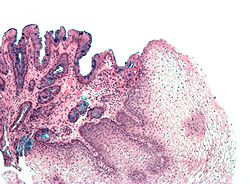
Glandular metaplasia is a type of metaplasia where irritated tissue converts to a glandular form.
An example occurs in the esophagus, where tissue becomes more similar to the tissue of the stomach.
Another example occurs in the urinary bladder.
See also
Additional images
-
 Micrograph of Barrett's esophagus, an example of glandular metaplasia.
Micrograph of Barrett's esophagus, an example of glandular metaplasia.
References
- "Metaplasia". Archived from the original on 2008-08-01.
- Ward AM (July 1971). "Glandular metaplasia and mucin production in transitional cell carcinomas of bladder". J. Clin. Pathol. 24 (5): 481. doi:10.1136/jcp.24.5.481-b. PMC 477052. PMID 5571853.
This article related to pathology is a stub. You can help Misplaced Pages by expanding it. |
| Pathology | |
|---|---|
| Principles of pathology | |
| Anatomical pathology | |
| Clinical pathology | |